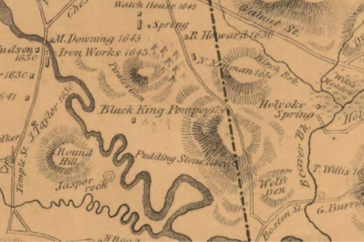The Inuit of Greenland have the most toxic bodies on the planet. A traditional people living in a pristine artic wonderland would seem the least likely to suffer
 |
| Lindsay Anibal, a senior from Old Greenwich, Conn., with sculpture "Trash Whale" hanging in the background. |
from the hazards of the industrialized world. But pollutants travel north through ocean currents and rivers, concentrating as they move up the food chain. The Inuit, at the top of that chain, eat minke whale and other large sea mammals whose fat contains dangerous levels of contaminants.
The Inuit were on Lindsay Anibal’s mind last spring. Now a senior pursuing a dual degree in studio art and behavioral ecology (a self-designed major), Anibal then caught wind of an initiative taking place in the Department of Art and Art History. The department chair, Professor Craig Hood, had connected with NextGen Climate NH, an advocacy group that works on college campuses to raise awareness about climate change, and with 3S Artspace in Portsmouth, N.H. The three groups were planning a 3S exhibit of UNH student, alumni and faculty artwork that responds to the topic of climate change. To Anibal, it seemed an exciting opportunity to combine interests in animal behavior and ecology with art, and to shed light on the effect of pollutants on sea mammals and humans.
“I wanted to focus less on what we usually think of when we think of climate change and more on some of our indirect effects on the environment, so I decided to target bioaccumulation in large marine mammals, which I think is a huge indicator of how we are damaging our planet,” says Anibal. “Larger marine mammals have ingested bits of plastic floating in the ocean as well as other garbage and are now toxic.”
The student decided to create a life-sized sculpture of a minke whale skeleton made completely from trash. The large scale would have impact. A painter and drawer, Anibal had never made a sculpture before, and this one would be about 25 feet long. It was a big undertaking that “consumed my life,” says Anibal.
Anibal collected garbage around campus for raw materials, some while walking, some during cleanup after campus events. And the student collected scores of cigarette butts.
“Cigarettes are one of the most horrible little micro-pollutions we do,” says Anibal. Most cigarette filters are made of cellulose acetate, a plastic.
Anibal used the cigarette filters to create the whale’s baleen plates — the keratin material attached to their upper jaws that filters food. Even months after creating and spray painting the plates, Anibal could still smell the smoky cigarette butts, “which attests to how long things that we just drop on the ground last in the environment.”
The student constructed the sculpture — rib by rib and vertebra by vertebra — in a small studio in the Paul Creative Arts Center in three segments, crossing fingers that it would look good when assembled in the exhibit space. It does. “Trash Whale” now hangs like a warning over the entire exhibit at 3S Artspace, too big to ignore.
“No one who uses a plastic bag is thinking about whales getting toxins in their bodies,” says Anibal, who wants to draw attention to the choices we make on a daily basis. “We live a consume-and-toss-away lifestyle. I think it's quite a tragedy.”
Anibal is one of 59 students and alumni whose art is featured in the exhibit. Works by UNH professors Grant Drumheller and Craig Hood and staff member
 |
| Cierra Vigue, a junior from Manchester, N.H., stands with art professor Brian Chu behind her ceramic sculpture that represents a bleached coral reef. When ocean waters warm too much, corals expel their algae, causing the coral to turn white. "I focus on hand building, and I like to do intricate work," says the studio art major, who painstakingly placed each piece on the reef. |
Kathleen Studebaker round out the offerings. About half of the students exhibiting are not art majors and some were taking their first art class when they created their pieces. To generate the work, faculty in studio arts courses assigned climate change responses as homework last spring. The output was impressive. Hood says there were many more fine works that could have been included but for space limitations.
Kate Corriveau, the press secretary for NextGen Climate NH, is pleased with the exhibit. “I'm incredibly blown away to be honest,” says Corriveau. “It is really clear that this is a very important issue to the students, and that this generation, especially, is very in tune with what climate change means for them and for their future if it's not addressed.”
“This is just the kind of show I want to walk into,” says Beth Falconer, the new executive director of 3S Artspace, who opened this exhibit during her very first week on the job. “A collaboration that brings together students, emerging artists and social issues is a wonderful fit for 3S.”
“Rise: Climate Change in Our World” is open now through November 12, 2016 at 3S Artspace in Portsmouth, N.H. The exhibition is free and open to the public. Gallery hours are Tuesday through Friday, 10 a.m. to 6 p.m., and Saturday from 12 to 5 p.m.
This event is part of the UNH Arts Initiative, a donor-funded project that supports UNH arts programming in New Hampshire, taking the great art created in Durham to all corners of the State.

All photos by Perry Smith Photography.
















































